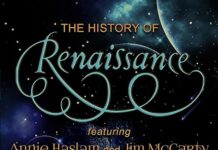Grand Funk Railroad was one of the first bands I wrote about for Vintage Rock. I reviewed a show they did at the Del Mar Fair. Grow up listening Grand Funk, I never got the chance to see them in the 70s. So catching two GFR shows during their 90s reunion — at Del Mar, and a few months later at the Greek Theatre with an orchestra — was a big deal for me. And it was only the beginning.
I eventually interviewed guitarist Mark Farner, drummer Don Brewer and bassist Mel Schacher after the reunion. We touched on the band’s highs and lows, the reissues of all the albums in the early 2000s, and why the reunion didn’t continue. These days, Brewer and Schacher carry on with Grand Funk, while Farner maintains a solo career. Just when I was ready to give up the possibility of anything “new” from the band, a long comes Marshall Blonstein’s Audio Fidelity with limited edition hybrid SACDs of two of the Funk’s albums from 1974 — Shinin’ On and All The Girls In The World Beware!!!.
Following a previous release of We’re An American Band on SACD, Audio Fidelity not only punched up the sound by going back to the masters, they also recreated the artwork, including actual 3D glasses (like the ones in the original package) to peruse the cover of Shinin’ On. Neil Adams’ cartoonish gatefold of the members of Grand Funk with bulging muscles and numerous females is also in the booklet of All The Girls In The World Beware!!!. As per their practice, Audio Fidelity went to great lengths to depict these albums in their original state within the CD format.
After tracking through the SACDs, I called Don Brewer to ask him what he thought. In the following exchange, the drummer fills me in on putting the SACDs together, and recalls the highlights of making the records themselves, and working with producers Todd Rundgren and Jimmy Ienner. He didn’t know much about any other “new” upcoming Grand Funk releases, but whetted my appetite with what he’d like to see released. Hearing that was enough to get my thing on the move.
~
The SACD reissues of Grand Funk’s Shinin’ On and All The Girls In The World Beware!!! are out. Tell me about your involvement.
The company Audio Fidelity did it with one of our other records, We’re An American Band. They basically look for the original master, then the whole idea is to make it sound as close to the vinyl as what it used to sound, except they’re going on a CD. They’re not putting any compression down so it will fit on a MP3 or any of that kind of stuff, so it’s wide open. That’s the whole premise of what they’re doing. And obviously they do sound great.
And why these particular titles?
I’m sure they’re probably looking at sales. They probably went back through the catalog and looked at sales, and are going accordingly. And I think they’re looking for the hit single. When we were more of a power trio from 1969 to 1972, we didn’t create a lot of singles. Yes, we had singles, but they weren’t big hit singles. I think they’re probably looking for that.
How involved were you in putting these SACDs together?
They got a guy who does this stuff. They came to me, looking for the masters. Capitol — Universal now — had the original masters for American Band. They also had the original for Shinin On’. The one for All The Girls In The World Beware!!!…they had trouble finding the original master that hadn’t been compressed, because now Universal is taking all of their catalog and they’re compressing it so they can fit more stuff on hard drives. So they’re compressing everything, and that’s exactly what Audio Fidelity did not want, was a compressed master.
Are you an SACD, high-resolution audio enthusiast?
Not really. When I see kids listening to MP3s in their earbuds, and they have this misconception that they’re hearing something that sounds really great, it just blows me away because they don’t know what vinyl or even what an uncompressed CD sounds like through a big amp and speakers. That’s the way to listen to stuff. So, I’m not a big audiophile, but I’m certainly not a big MP3 fan either (laughs).
Both these titles were released in 1974, pretty much at the height of the group’s commercial run. At the same time, there were some internal issues within the band. I’d imagine the pressure was high at this point to stay on top.
We were in a sink or swim position, really when it came to American Band. We were being sued by our former manager, and a couple crooked attorneys had taken all our money. We were basically flat broke. At the same time, FM radio had changed from an underground format into being a commercial hit format. So we were faced with either we were going to become obscure and nobody’s going to be paying attention to us anymore, or we’re going to start cranking out some hit singles. So we enlisted Todd Rundgren as our first production choice to go in and work with American Band. I started to do a little more singing and songwriting, thinking I could lend a little more to the commercial end of things.
We put this whole combination together and we were trying, number one, make some money, and also avoid going obscure, which could have easily happened. We made the switch and started pumping out the singles. We had to and it’s a good thing we did. I think a lot of the music now that’s really remembered the most is these commercial hits.
You mentioned how you were singing and writing more. Did Todd Rundgren encourage that?
He was an inspiration. I think working with Todd…I mean there’s Todd Rundgren in the control room and he’s cranking the knobs and making everything sound great in the headphones, which was totally unheard for us. We were used to going into the studio, having everything recorded absolutely flat with no EQ, no echo, no nothing. That’s what you were hearing in the headphones. Everything was supposed to go on later in the mix. Todd just threw all that out the window. He said, “This is what it’s going to sound like at the end anyway, so I’m going to make it sound like that now.” So he did. He recorded it to 24 track, just like that. And it sounded great in the headphones. So it was an inspiration to work with him. He had a lot of great ideas on where to put the bridge in a song, just commercializing it, just really a good feel for that commercial hit kind of stuff.
How different was it working with Jimmy Ienner?
Jimmy was a pop guy too. He had worked with the Raspberries and Three Dog Night and several others. And we looked at him for the same reason. We wanted to keep that trend of hits of going on. We were also facing at that point — 1974, 75 — rock was fading and disco was coming in and we weren’t going to be a disco act. So we started focusing a little more on R&B. Grand Funk is really kind of an R&B band pumped up on steroids. We focused a little more on the R&B and it worked. We came up with “Some Kind Of Wonderful” that way. It’s an old soul classic by the Soul Brothers Six.
I tracked through the SACDs last night and while I admit I was more of a fan of the earlier 70s power trio version of Grand Funk —
— As was I. I loved doing that stuff. We got the point where we couldn’t produce seven-minute songs and get on the radio.
Yeah, I understand that. Listening to SACDs, I developed a new appreciation for some of the songs I passed on before. You had songs like “Carry Me Through” and “Gettin’ Over Me,” which you and Craig Frost wrote. Seems like something was happening as far as you two writing songs.
When Craig came into the band in 1972, he was a former member of a couple of other bands that we were in, in the past. We brought Craig back because he missed the Grand Funk thing when were a power trio. He had to drop out of the band way back when because he had a kid and he was married and he couldn’t struggle through the way we were struggling. He just couldn’t do it. So we went on and became a power trio. But we brought Craig back. Craig was a very old friend of ours and he lent a whole other deal. “Here’s an idea” and “here’s an idea.” He was bringing in keyboard-based ideas, not guitar-based ideas. So he took things off in a different direction.
You were also adding horns to some of the songs. You have horns on “To Get Back In,” and on All The Girls In The World Beware!!!, you have them on three songs.
“To Get Back In” is a great track. To me, it’s a real R&B song. And it’s very reflective of what I think everyone in the band grew up on. I love that song.
Were you happy using horns on these songs?
I was never big on the horn idea. It came down to, “Do we try to do these parts with keyboards, or do we bring in real horns?” Jimmy Ienner was the producer at that time. “To Get Back In,” Todd did that. We put horns on that later. The horns came in when Jimmy Ienner was in there. I was never a big horn guy, but Jimmy wanted to bring in the horns because that’s what he wanted to do (laughs). He was the producer and he wanted to put on the horns (laughs).
Mark Farner has his ballads like “Memories” and “Bad Time,” and you and Craig Frost came up with this cool groove called “Good & Evil” where you deliver a smoky, spoken-word vocal. Where did that come from?
That was visiting the dark side, I suppose (laughs). This guy is probably in all of us…just wanting to go out and be bad. That’s kind of what that was all about.
The packaging for these records spared no expense back in the day — the 3D glasses for Shinin’ On, and the cover and poster of the band in beefcake mode for All The Girls In The World Beware!!!. And the SACDs have reproduced this. Back then, were you involved in the packaging of the records?
These were ideas that were brought by the record company first, and then later, when we hired Lynn Goldsmith who was our publicist for awhile and she was throwing in all these ideas. We were totally supportive of it, because that what was going on at the time. All the bands were competing. Here you had this beautiful, big piece of album cover. What can you do with it? You could do a ton of stuff. It was a big competition to see how outrageous you could get with the artwork on that stuff. We were totally into it. We were in competition with everybody else out there. It was the same thing with the gold vinyl. On We’re An American Band, we used virgin vinyl on the single and the album.
Are there plans for more Grand Funk SACDs? Do they keep you in the loop on that?
They don’t keep me in the loop on crap (laughs). No, it’s totally up to them. If they do decide to do it, it will be based on sales. The bean counters always have their day. They’ll go to Universal and try to find the original masters and do the same thing. That’s the general way they do stuff. I hope those masters haven’t been converted at this point. If they have, we will have absolutely no way to find the original masters. Luckily, I was able to find the original master to All The Girls In The World Beware!!!. We had it in a storage unit that we keep for the band. But those older albums, those were all done at Cleveland Recording, which is now defunct and gone. There’s no telling where any original masters might be for that stuff.
Is there anything else by Grand Funk you’d like to see reissued, repackaged or released?
Pretty much everything is out there. The only thing that has never been released is Shea Stadium live, audio or video. There’s a beautiful video done by the Maysles Brothers of that concert, Grand Funk At Shea Stadium. That, at some point, will probably make its way out there. Once again, it all comes down to finances and is it worth it. The kind of odd thing about the Shea Stadium thing is we were huge at that time and we didn’t really hadn’t had any hit singles. It was all album oriented radio. So people that are watching the Shea Stadium are going, “Wow, where’s ‘American Band’? Where’s ‘Shinin’ On’? Where’s ‘Locomotion’? Where’s ‘Some Kind Of Wonderful’?” They came later (laughs).
You also have the Bosnia concert that never came out.
No, it never came out.
Audio Fidelity is also reissuing vinyl. Has there been any talk about that?
I haven’t heard anything about that. I understand that vinyl is definitely making a comeback. Somebody told me, “Oh yeah, kids are really into that.” And I said, “Well, I hope they’re not listening to vinyl on those little earbuds. They’re defeating the whole purpose (laughs).
Right. So what’s happening with Grand Funk these days?
We’re still touring. We do 35 to 40 shows a year. We’ve had the same guys in the band for 17 years now. It’s going great. The last year, 2016 was our best year of the last 20, so we’re still cranking away.
Are you still playing with Bob Seger as well?
I have since 2006. I played with that band back in the 80s for a couple of tours. Since 2006, I’ve done five or six tours with Bob. I never know. We always have to work on a schedule. It depends on when he’s going out and what I’m doing at the time.
The possibility of a band like Grand Funk getting into the Rock & Roll Hall of Fame seems more likely these days.
Why do you say that?
They’ve become friendlier and more receptive towards popular bands like Grand Funk. Kiss got in, Rush got in. Fans are getting to vote these kinds of bands in.
Because they’re running out of good people to put in (laughs).
I think that’s true. If it ever happens, what would you like to see go down with Grand Funk on that night?
I don’t even speculate on it. I kind of ruled it out years ago. The whole thing is controlled by Rolling Stone magazine. Most of the time it was Rolling Stone darlings that made it into the Rock & Roll Hall of Fame and we were never Rolling Stone’s favorite acts, so there you go (laughs).




















